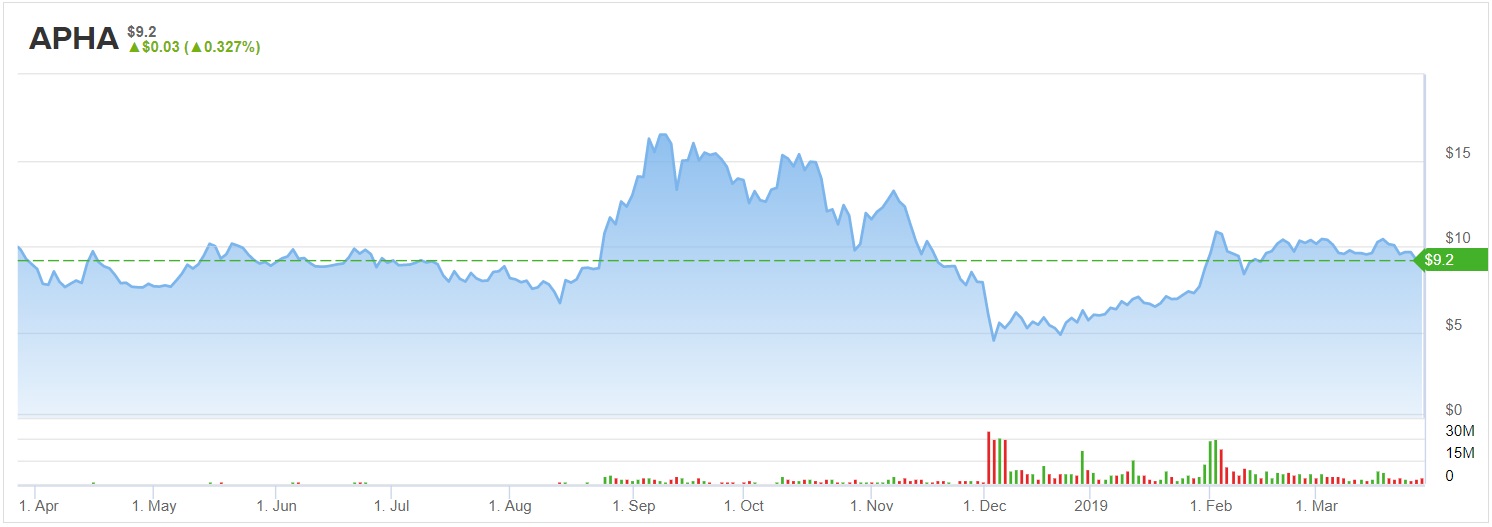With a market cap hovering at $3 billion, Aphria (APHA) remains one of the largest companies operating within the high-growth cannabis arena. So far 2019 has been a great year for Aphria stock. Although the stock tumbled in the fourth quarter of 2018, APHA has soared over 60% this year.

Aphria through late 2018 and early 2019 experienced hostile bids from Green Growth Brands (GGB) which led to higher share price premiums (that ultimately dissipated as the sector rallied between December and January), but was rejected last month. This broadly allows Aphria to refocus on core operational activities, primarily production, which is now reaching circa 255,000 kilograms of cannabis annually.
As further discussed below, Canopy Growth (CGC) retains a cost per gram of $2-$3 while Aphria is currently reporting an aggregated cost per gram of $0.95 as of Q4 2018. This is a somewhat exaggerated comparison, as the specialized nature of liquids production by CGC inflate overall cost per gram production costs relative to that of companies producing dry cannabis. Yet it remains a firm reminder to the benefits of using natural energy in this type of production process.
Furthermore, management recently laid out mid term plans for the company that included reaching $1 billion in revenues by 2020, up from circa $200m in 2018. This indicates substantial upside should management execute this transformation over the upcoming 24 months successfully.
Competitive Advantage
The core competitive long-term advantage Aphria maintains is its expertise in utilizing greenhouses and sunlight to provide the energy requirements for growing this crop, especially important considering the scale and scope Aprhia envisions moving forward. The average cost per gram ranges between $2-$4 for most large-scale producers, with long-term averages likely to sit between $1-$2 at scale a decade from now.
The efficiencies made in reducing the overall cost structure of production remains a firm catalyst for margin improvements relative to competitors. In short, it would allow Aphria to be a low-cost producer in a largely commoditized space, adding a margin of safety and flexibility to mid to long term operations.
However, while Aphria is the frontrunner in using this format of greenhouses and natural sunlight, should the long-term economics scale up in a particularly favorable way it is likely other major actors and competitors would invest in similar assets at a scale as significant as Aphria. The does add a level of doubt as to the durability of this advantage should it play out as expected.
Bottom line
Aphria specifically retains a unique approach to cannabis production at scale, and with revenues set to hit $1 billion by 2020 the upside remains material should the company execute in line with projections and expectations.
The cost per gram metrics of sub $1 indicates a material decrease in production cost compared to most competitors. In theory, this provides a catalyst for margin improvements as the company scales up, reducing relative operational losses that competitors such as Canopy have endured in recent years. However, while cost per gram is an important metric to consider, other operational areas such as marketing spend may erode any comparative advantage Aphria retains in term of low-cost production.
To read more on the nitty gritty of what’s going on in the rising cannabis industry, click here.